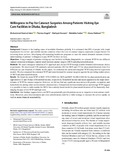Willingness to pay for cataract surgeries among patients visiting eye care facilities in Dhaka, Bangladesh
Citation
Islam, M. N., Engels, T., Hossain, S., Sarker, M., & Rabbani, A. (2019). Willingness to pay for cataract surgeries among patients visiting eye care facilities in Dhaka, Bangladesh. Applied Health Economics and Health Policy, 17(4), 545-554. doi:10.1007/s40258-019-00478-3Abstract
Background Cataract is the leading cause of avoidable blindness globally. It is estimated that 89% of people with visual
impairment live in low- and middle-income countries where the cost of cataract surgery represents a major barrier for
accessing these services. Developing self-sustaining healthcare programs to cater the unmet demands warrants a better
understanding of patients’ willingness to pay (WTP) for their services.
Objectives Using a sample of patients visiting eye care facilities in Dhaka, Bangladesh, we estimate WTP for two diferent
cataract extraction techniques, namely small incision cataract surgery (SICS) and phacoemulsifcation.
Methods We used contingent valuation (CV) approach and elicited WTP through double-bounded dichotomous choice
experiments. We interviewed 556 randomly selected patients (283 for SICS and 273 for phacoemulsifcation) from fve
diferent eye care hospitals of Dhaka. In this paper, we estimated the mean and marginal WTP using interval regression
models. We also compared the estimated WTP and stated demand for cataract surgeries against the prevailing market prices
of SICS and phacoemulsifcation.
Results We found the mean WTP of BDT 7579 (US$93) for SICS and BDT 10,208 (US$126) for phacoemulsifcation are
equivalent to 12 and 16 days of household income, respectively. Household income and assets appeared as the major determinants of WTP for cataract surgeries. However, we did not fnd any signifcant association with gender, occupation, and
household size among other socioeconomic characteristics. Comparisons between market prices and average WTP suggest
it is possible to have a viable market for SICS, but a subsidy-based model for phacoemulsifcation will be fnancially challenging because of low WTP and high costs.
Conclusion Our fndings suggest lower-cost SICS can potentially provide patients access to surgeries to treat cataract conditions. Moreover, price discrimination and cross-subsidization could be a viable strategy to increase the service-uptake as
well as ensure fnancial sustainability

